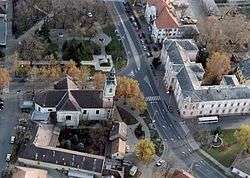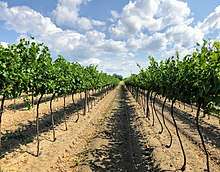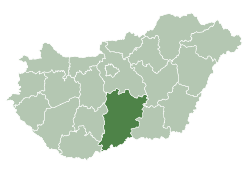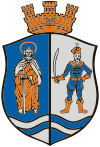Kiskőrös
Kiskőrös (Slovak: Malý Kereš / Kiškereš, Yiddish: קישקעריש Kishkerish, German: Körösch, Croatian: Kireš[1]) is a town in Bács-Kiskun, Hungary. Kiskőrös is situated between the Danube and Tisza rivers at around 46°37′14″N 19°17′19″E. Sándor Petőfi, the national poet of Hungary, was born here.
Kiskőrös | |
|---|---|
 Aerial view | |
 Coat of arms | |
 Kiskőrös Location of Kiskőrös | |
| Coordinates: 46.62038°N 19.28381°E | |
| Country | |
| County | Bács-Kiskun |
| Area | |
| • Total | 102.23 km2 (39.47 sq mi) |
| Population (2009) | |
| • Total | 14,452 |
| • Density | 143.3/km2 (371/sq mi) |
| Time zone | UTC+1 (CET) |
| • Summer (DST) | UTC+2 (CEST) |
| Postal code | 6200 |
| Area code(s) | 78 |
| Website | http://www.kiskoros.hu/ |
Geography
Kiskőrös is the sixth biggest city in Bács-Kiskun county by population. It is located in the center of the county, 22 kilometres (14 miles) east from the river Danube and 110 km (68 mi) south of Budapest. About 2–3 km (1–2 mi) north of the town lies the nature reserve area (since 1974) of Szücsi Forest as part of the Kiskunság National Park. The flora includes close to 300 protected plant species, one of them a special species of orchid, which blossoms here in April. Moreover, there are 98 registered, protected bird species. Many of them are songbirds that coexist with birds of prey like kestrels, sparrow-hawks and hobbies.
Climate
Kiskőrös has a continental climate combined with a high number of yearly sunlight. The hours of annual sunlight is over 2,000 hours.
History
Kiskőrös has been populated since the Stone Age. In the first half of the second millennium before Christ it was populated by the Vatya-culture which was developed around the central area of the Danube basin between 2000 and 1500/1400 BC.[2] Archeologists unearthed 161 metal objects - out of them 11 made of gold - in the vicinity of Kiskőrös in 2016, representing the biggest ever Middle Bronze Age found - both quantity and quality - in the areas between the Danube and Tisza (in Hungarian: Duna-Tisza köze).[3][4] In addition to bronze and gold jewellery, daggers, spears, axes as well as goldsmith tools were found. Celtic coins from the Late Iron Age (4th century B.C.) have also been found. In the first century Transdanubia (i.e. Pannonia) was invaded by the Romans and its population ran away and settled in the area. Archaeological evidence suggests that Scythian-Sarmatian were settled here, to the border region, to protect the "limes", who continued to be present up to the 5th century AD. Seven sarmata cemeteries have been found so far within the permiaters of Kiskőrös. In the graves of a Jazig-Sarmatian cemetery a necklace of pearls in gold setting and other rare polished jewellery were found.[5] In the 1930s five Avar villages and seven cemeteries have been discovered. The archeological findings strongly suggest a strong connection between the Sarmatians living in the area and the Roman provinces. Only a few relics were have been found from the Hun-period (420-454). Nine Avar cemeteries have been dug so far. Their characteristic metal buckles with a griffin fitting are strikingly similar to those found in the Caucasus and along the River Volga. The most beautiful findings of all, a necklace of 5 oval almandine pendants in gold setting and 6 gold pendants were uncovered in a princes's grave.[6] The first written documents mentioning Kiskõrös date back to 1277 issued by the "Kuman" László IV and referred to as "Keurus". By 1433 Kõrös was an independent town. The peaceful life of the town came to an end in the 16th century when the Turkish army occupied the region. A letter was written on April 11, 1529 by Mihály Pósa warning the bishop of Kalocsa about the attacks of the Turks. He informs the bishop that Kiskőrös was ruined by the Turks 8 April together with other settlements in the area. The town lceased to exist during the occupation and referred to as "puszta" (lat. desertum). n 1702 documents show that the area was not fully uninhabited. The rebirth of Kiskõrös is the work of the Wattay [7] family. For their contribution to defeat the Turks, Leopold I gave the family the land and the surrounding areas.[8] On May 19, 1718 700 Slovak farmers moved to Kiskõrös. The population has reached 5,000 by 1785. On January 1, 1823 Sándor Petőfi was born in Kiskõrös. In the 20th century Hungary lost both world wars and during the years of the Great Depression the economy of the village suffered greatly. Kiskõrös was occupied by the Soviet Army in 1944. After World War II, most of the income came from agriculture (wine and fruit production). In the 1950s, when drilling for oil, salty-iodous-brominous medicinal thermal water of 56 °C was found, forming the basis of the popular thermal bath and swimming pool.[9] Kiskőrös began to develop rapidly in the 1970s and infrastructure, educational, healthcare and welfare institutions were built. Kiskõrös became a town again in 1973.
Economy
The largest part of the economy is provided by the service sector (family enterprises) and agriculture (mainly related to winegrowing and fruits).
Wine

Kiskőrős is situated in the middle of Hungary largest wine producing region, the "Kunsági borvidék" and its history is intimately entwined with wine-making. The sandy soil and high sunshine hours provide the perfect conditions for grape. Wine-growing in Kiskőrös is first mentioned in written documents from the XIII. century.[10] After the city was ruined during the Ottoman wars, For over 200 years there has been a deep tradition of grape production and wine making in this region. As such, a large percentage of the town workforce is devoted to the grape and wine industry in the area wine producing region (Kunsági borvidék) Kiskőrös is known for and the local population has strong ties to its wine-growing and wine-production. Home winemaking has been an important part of the local culture and self-identityi as well as a defining part of family tradition. The most well-known traditional grapes are: „Kövidinka” – “Ezerjó” – "Sárfehér", "Bianca" and the "Kadarka".
Demographics
Kiskőrös had 15,348 residents in 2001. The population is homogeneous with a Hungarian majority. (95.8% Magyars, 3.1% Slovaks, 1.4% Romani, 0.7% Germans etc.). The distribution of religions were: 46.4% Lutheran, 27.5% Roman Catholic, 4.5% Calvinist etc.).[11]
Personalities
- Sándor Petőfi, Hungarian national poet
Buildings and structures
East of Kiskörös, there is a 150 metres (490 ft) tall concrete tower used for FM radio and television broadcasting.
Twin towns – Sister cities
The city is twinned with eight cities:[12]








Gallery
References
- (in Croatian) "Folia onomastica croatica 14/2005". (462 KB) Živko Mandić: Hrvatska imena naseljenih mjesta u Madžarskoj,
- http://www.archaeology.wiki/blog/2014/03/14/revealing-the-secrets-of-4000-year-old-settlements-in-hungary/
- https://www.youtube.com/watch?v=8eTJ0b_qiNA
- http://www.baon.hu/bacs-kiskun/kultura/szenzacios-aranykincsek-a-bronzkorbol-675983/
- http://www.grunwald.hu/kiskoros/Internat/english.htm
- http://www.grunwald.hu/kiskoros/Internat/english.htm
- hu:Wathay család
- "Archived copy". Archived from the original on 2007-11-30. Retrieved 2017-04-27.CS1 maint: archived copy as title (link)
- http://gotohungary.com/more-spas/-/netaview/37713;jsessionid=AFD1FC9F96BF70F7336238C0A5FECEE6
- "Kiskőrösi Gondűző Borlovagrend". www.borrend.hu. Retrieved 2020-01-09.
- Gazetteer of Hungary 2009 (Hungarian)
- "Testvértelepülések". Retrieved 30 April 2014.



